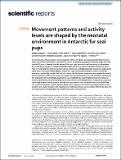Files in this item
Movement patterns and activity levels are shaped by the neonatal environment in Antarctic fur seal pups
Item metadata
| dc.contributor.author | Nagel, Rebecca | |
| dc.contributor.author | Mews, Sina | |
| dc.contributor.author | Adam, Timo | |
| dc.contributor.author | Stainfield, Claire | |
| dc.contributor.author | Fox-Clarke, Cameron | |
| dc.contributor.author | Toscani, Camille | |
| dc.contributor.author | Langrock, Roland | |
| dc.contributor.author | Forcada, Jaume | |
| dc.contributor.author | Hoffman, Joseph I | |
| dc.date.accessioned | 2021-07-27T10:30:11Z | |
| dc.date.available | 2021-07-27T10:30:11Z | |
| dc.date.issued | 2021-07-12 | |
| dc.identifier | 275202245 | |
| dc.identifier | 5f8b4323-7312-438a-a236-60f7811901e5 | |
| dc.identifier | 85110583402 | |
| dc.identifier | 000677494000009 | |
| dc.identifier.citation | Nagel , R , Mews , S , Adam , T , Stainfield , C , Fox-Clarke , C , Toscani , C , Langrock , R , Forcada , J & Hoffman , J I 2021 , ' Movement patterns and activity levels are shaped by the neonatal environment in Antarctic fur seal pups ' , Scientific Reports , vol. 11 , 14323 . https://doi.org/10.1038/s41598-021-93253-1 | en |
| dc.identifier.issn | 2045-2322 | |
| dc.identifier.other | RIS: urn:851A10D10E59BCA2841A60363AA41812 | |
| dc.identifier.uri | https://hdl.handle.net/10023/23648 | |
| dc.description | This research was funded by the German Research Foundation (DFG) as part of the SFB TRR 212 (NC3)—Project Numbers 316099922, 396774617, and 396782756. It was also supported by core funding from the Natural Environment Research Council to the British Antarctic Survey’s Ecosystems Program. | en |
| dc.description.abstract | Tracking studies of juveniles are rare compared to those of adults, and consequently little is known about the influence of intrinsic and extrinsic factors on activity during this critical life stage. We used hourly GPS data, collected from 66 Antarctic fur seal pups from birth until moulting, to investigate the explanatory power of multiple individual-based and environmental variables on activity levels. Pups were sampled from two nearby breeding colonies of contrasting density during two subsequent years, and a two-state hidden Markov model was used to identify modalities in their movement behaviour, specifically 'active' and 'inactive' states. We found that movement was typified by central place exploration, with active movement away from and subsequent return to a location of inactivity. The probability of such directed exploration was unaffected by several factors known to influence marine mammal movement including sex, body condition, and temperature. Compared to pups born at the high-density colony, pups at low-density were more active, increased their activity with age, and transitioned earlier into the tussock grass, which offers protection from predators and extreme weather. Our study illustrates the importance of extrinsic factors, such as colony of birth, to early-life activity patterns and highlights the adaptive potential of movement. | |
| dc.format.extent | 12 | |
| dc.format.extent | 1773199 | |
| dc.language.iso | eng | |
| dc.relation.ispartof | Scientific Reports | en |
| dc.subject | Behavioural ecology | en |
| dc.subject | Ecology | en |
| dc.subject | GC Oceanography | en |
| dc.subject | QH301 Biology | en |
| dc.subject | DAS | en |
| dc.subject | SDG 14 - Life Below Water | en |
| dc.subject.lcc | GC | en |
| dc.subject.lcc | QH301 | en |
| dc.title | Movement patterns and activity levels are shaped by the neonatal environment in Antarctic fur seal pups | en |
| dc.type | Journal article | en |
| dc.contributor.institution | University of St Andrews. Statistics | en |
| dc.identifier.doi | 10.1038/s41598-021-93253-1 | |
| dc.description.status | Peer reviewed | en |
This item appears in the following Collection(s)
Items in the St Andrews Research Repository are protected by copyright, with all rights reserved, unless otherwise indicated.

